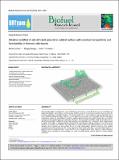Files in this item
Alkaline modified A-site deficient perovskite catalyst surface with exsolved nanoparticles and functionality in biomass valorisation
Item metadata
| dc.contributor.author | Umar, Ahmed | |
| dc.contributor.author | Neagu, Dragos | |
| dc.contributor.author | Irvine, John T.S. | |
| dc.date.accessioned | 2021-03-09T16:30:10Z | |
| dc.date.available | 2021-03-09T16:30:10Z | |
| dc.date.issued | 2021-03-01 | |
| dc.identifier | 273233697 | |
| dc.identifier | df22c81f-3d1e-4955-bdbf-ea31132b43ec | |
| dc.identifier | 85103132318 | |
| dc.identifier | 000624550600004 | |
| dc.identifier.citation | Umar , A , Neagu , D & Irvine , J T S 2021 , ' Alkaline modified A-site deficient perovskite catalyst surface with exsolved nanoparticles and functionality in biomass valorisation ' , Biofuel Research Journal , vol. 8 , no. 1 , pp. 1342-1350 . https://doi.org/10.18331/BRJ2021.8.1.5 | en |
| dc.identifier.issn | 2292-8782 | |
| dc.identifier.other | RIS: urn:9BCCBA7D5E58992F301DBE938C5B068B | |
| dc.identifier.other | RIS: 127216 | |
| dc.identifier.other | ORCID: /0000-0002-8394-3359/work/90567113 | |
| dc.identifier.uri | https://hdl.handle.net/10023/21575 | |
| dc.description | The authors would like to thank the Petroleum Technology Development Fund (Nigeria) for funding this research and University of St Andrews (Scotland, UK) for the opportunity to carry out the research. | en |
| dc.description.abstract | Environmental problems associated with the use of fossil fuels and increase in energy demands due to rise in population and rapid industrialisation, are the driving forces for energy. Catalytic conversion of biomass to renewable energies is among the promising approaches to materialize the above. This requires development of robust catalysts to suppress deactivation due to carbon deposition and agglomeration. In this work, surface properties and chemistry such as exsolution of B-site metal catalyst nanoparticles, particle size and distribution, as well as catalyst-support interactions were tailored through the use of alkaline dopants to enhance catalytic behaviour in valorisation of glycerol. The incorporation of alkaline metals into the lattice of an A-site deficient perovskite modified the surface basic properties and morphology with a consequent robust catalyst-support interaction. This resulted in promising catalytic behaviour of the materials where hydrogen selectivity of over 30% and CO selectivity of over 60% were observed. The catalyst ability to reduce fouling of the catalyst surface as a result of carbon deposition during operation was also profound due to the robust catalyst-support interaction occurring at the exsolved nanoparticles due to their socketing and the synergy between the dopant metals in the alloy in perovskite catalyst systems. In particular, one of the designed systems, La0.4Sr0.2Ca0.3Ni0.1Ti0.9O3±δ, displayed almost 100% resistance to carbon deposition. Therefore, lattice rearrangement using exsolution and choice of suitable dopant could be tailored to improve catalytic performance. | |
| dc.format.extent | 9 | |
| dc.format.extent | 9252492 | |
| dc.language.iso | eng | |
| dc.relation.ispartof | Biofuel Research Journal | en |
| dc.subject | Surface chemistry | en |
| dc.subject | Steam reforming | en |
| dc.subject | Syngas | en |
| dc.subject | Biofuel | en |
| dc.subject | Fuel cell | en |
| dc.subject | QD Chemistry | en |
| dc.subject | NDAS | en |
| dc.subject | SDG 7 - Affordable and Clean Energy | en |
| dc.subject.lcc | QD | en |
| dc.title | Alkaline modified A-site deficient perovskite catalyst surface with exsolved nanoparticles and functionality in biomass valorisation | en |
| dc.type | Journal article | en |
| dc.contributor.institution | University of St Andrews. Centre for Designer Quantum Materials | en |
| dc.contributor.institution | University of St Andrews. School of Chemistry | en |
| dc.contributor.institution | University of St Andrews. EaSTCHEM | en |
| dc.identifier.doi | 10.18331/BRJ2021.8.1.5 | |
| dc.description.status | Peer reviewed | en |
| dc.identifier.url | https://www.biofueljournal.com/jufile?ar_sfile=1258493 | en |
This item appears in the following Collection(s)
Items in the St Andrews Research Repository are protected by copyright, with all rights reserved, unless otherwise indicated.

